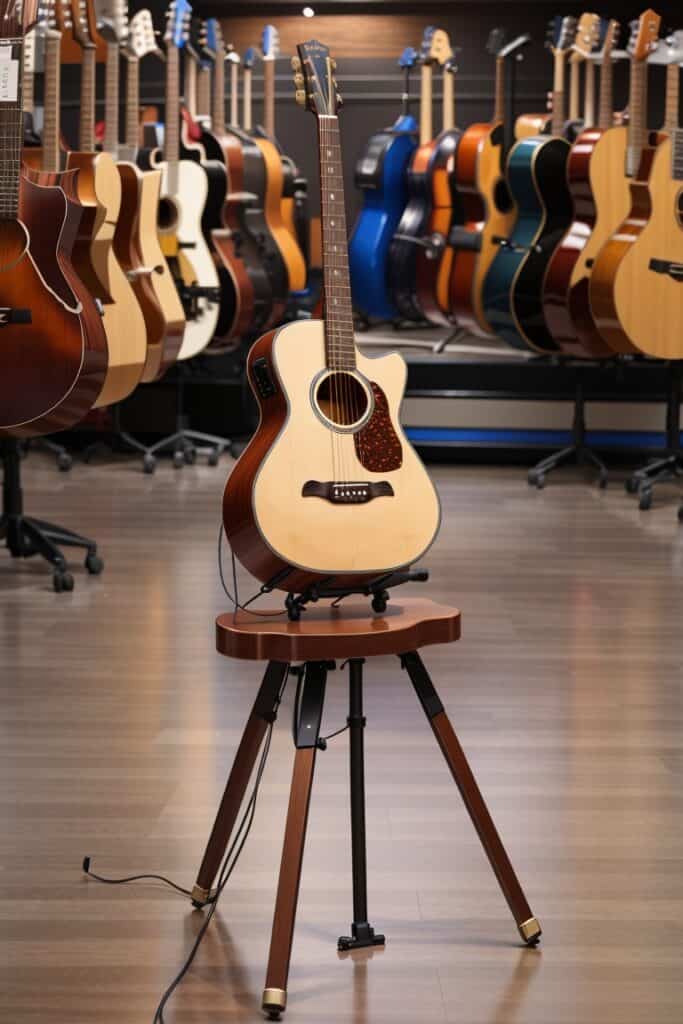What is it about the gentle resonance of an acoustic guitar that can elicit profound emotions and sway our souls? Perhaps it’s the organic, unembellished genuineness, or the raw talent it takes to make the instrument sing without the aid of electronic gear. Or, maybe, it’s because some of the greatest guitar players, such as James Taylor, have chosen the acoustic guitar as their signature instrument.
James Taylor, an accomplished singer-songwriter, has comforted countless souls with his unique guitar-playing style and deeply moving lyrics. Let’s explore James Taylor’s guitar selection throughout his illustrious career and discuss the profound impact he has had on the guitarist community.
James Taylor: His Acoustic Journey
Before we explore what kind of guitar James Taylor plays, it’s essential to appreciate his compelling musical journey. Taylor’s easy-listening style, gentle acoustic guitar melodies, and heartfelt lyrics have positioned him as one of the most influential guitar players over the past five decades. His talents were globally recognized when he was inducted into the Rock and Roll Hall of Fame in 2000, a testament to his immense contribution to the music world.
The James Taylor Guitar: More than an Instrument

The guitar that has become synonymous with James Taylor over the decades is the Signature Model Dreadnought from the renowned C.F. Martin & Co., known simply as the Martin JTSM. This guitar is the product of a collaboration between James Taylor and the skilled craftsmen at Martin. Its distinguishing features include an enlarged soundhole, a wide neck, and specially treated wood for a mature, aged tone.
The Martin JTSM stands out as an instrument designed to cater to Taylor’s unique guitar style. The dreadnought body, a design first popularized by Martin, offers a robust, powerful sound, while the enlarged soundhole boosts the instrument’s volume and resonance.
This acoustic guitar also features a unique neck design, wider than average to accommodate Taylor’s fingerstyle guitar playing. It also has an adjustable neck rod, a feature James Taylor found invaluable for tweaking the guitar’s action based on his preferences.
The materials used in the guitar’s construction are noteworthy. The top is made of Sitka spruce, renowned for its expansive dynamic range and crisp articulation. The back and sides are composed of East Indian rosewood, prized for its deep bass and brilliant treble tones. Additionally, the top wood of the JTSM has been specially treated to give it the sound and appearance of an aged, vintage instrument.
The Signature Model: Beyond the Specs
While the specifications of the Martin JTSM are impressive, they only tell half the story. The true magic of this guitar comes alive in the hands of its master player, James Taylor. Taylor’s fingerstyle technique, his unique fusion of rhythm and melody, and his gentle touch, allow the nuanced tones of this remarkable instrument to shine. The sound this combination produces is reminiscent of his debut album, ‘Sweet Baby James,’ a testament to the enduring quality of his music.
The JTSM, specifically designed for Taylor, forms an ideal alliance between the artist and his guitar. Its unique features such as the larger soundhole, wider neck, and adjustable action, all cater to Taylor’s specific guitar playing style, allowing him to effortlessly weave his signature acoustic sound.
Exploring James Taylor’s Other Guitar Choices
Though the Martin JTSM has been James Taylor’s guitar of choice for a substantial part of his career, he has occasionally played other guitars. In his early years, Taylor often performed with a Gibson J-50, a choice popular among folk musicians of the 1960s. This guitar sported a dreadnought body shape and a combination of spruce and mahogany tonewoods, offering a warm, mellow tone that complemented Taylor’s style.
In more recent times, Taylor has occasionally performed with a custom Olson SJ, meticulously crafted by James Olson. This guitar, made of a blend of cedar and rosewood, presents a lush, resonant tone that perfectly complements Taylor’s fingerpicking technique.
The Gibson J-50: Echoing Taylor’s Early Years

As mentioned earlier, during the initial years of his career, James Taylor was frequently seen performing with a Gibson J-50. This guitar, with its dreadnought body shape, produced a large and bold sound that meshed well with Taylor’s vocals, becoming a staple in his early performances.
The Gibson J-50 combines spruce and mahogany tonewoods in its construction. Spruce, popular for soundboards due to its dynamic and clear sound, pairs well with mahogany, which offers a warm, mellow tone. This blend creates a balanced, rich, and full sound with a particular emphasis on mid-range frequencies, ideal for Taylor’s soothing vocal style. This guitar, reliable and harmonious, was a crucial part of Taylor’s early sound.
The Custom Olson SJ: A Testament to Taylor’s Evolving Sound
As Taylor’s music matured, his choice of guitars evolved too. In recent years, he’s occasionally been seen with a custom Olson SJ (Small Jumbo). This guitar is a testament to his evolving sound and a masterpiece crafted by James Olson, a luthier highly respected for his dedication to acoustic perfection.
Despite being smaller than a traditional jumbo guitar, the Olson SJ offers a deep, resonant tone, partly due to its tonewoods: a cedar top paired with rosewood back and sides. Cedar, popular among fingerstyle players like Taylor for its warm, dark tone, and quick response, pairs excellently with rosewood. The latter provides deep lows and sparkling highs, offering a broad dynamic range and rich harmonic content. This combination creates a lush, full-bodied tone that pairs wonderfully with Taylor’s fingerpicking technique. Indeed, James Taylor found the Olson SJ to be a perfect accompaniment to his evolving sound and style.
Another remarkable aspect of the Olson SJ is its meticulous craftsmanship. Each guitar is painstakingly handcrafted, resulting in an instrument that’s as visually striking as it is sonically rich. From the elaborate inlays to the finely polished finish, the intricate attention to detail aligns well with Taylor’s approach to music – thoughtful, nuanced, and persistently striving for perfection.
James Taylor’s selection of the custom Olson SJ echoes not only his evolution as an artist but also his unyielding commitment to achieving the finest possible sound. It stands as a testament that a musician’s journey is never static, but continuously shaped by their experiences, influences, and the instruments they choose to express their artistry.
The Signature Sound of James Taylor
While a guitar is a crucial component in creating sound, it’s just one piece of the complex puzzle that is a musician’s signature sound. James Taylor’s unique sound is a result of his masterful technique, distinct style, and a myriad of other factors, including his choice of guitars.
The Impact of James Taylor’s Guitar Choices
We’ve delved extensively into James Taylor’s favored guitars, but why does this matter? What influence does his choice have on his music, and what insights can we, as guitar enthusiasts or budding musicians, glean from it?
The Guitar: An Extension of the Artist
Especially for an artist like James Taylor, a guitar isn’t merely an instrument – it’s an extension of the artist. Taylor’s Martin JTSM, with its unique specifications and customized design, aligns seamlessly with his musical style and enriches his performance. This synergistic relationship between a musician and their instrument is a crucial element in crafting compelling, authentic music.
The Significance of the Right Guitar
While talent and technique are crucial, the ‘right’ guitar can make a significant difference in the quality of the music produced. The tonal properties and playability of the Martin JTSM enable Taylor to produce the warm, soothing sounds that have become his trademark. The key takeaway here for aspiring musicians is clear: selecting a guitar that complements your playing style can enhance your musical abilities and aid in the discovery of your unique voice.
Craftsmanship and Quality: The Undeniable Connection

Lastly, Taylor’s preference for a high-quality, carefully crafted instrument highlights the importance of craftsmanship and quality in achieving superior sound. While the Martin JTSM is certainly a significant investment, the outstanding sound quality, ease of play, and longevity it offers make it a worthwhile investment for a dedicated musician. The emphasis on craftsmanship and quality in Taylor’s choice serves as a valuable lesson for musicians at all levels of expertise.
Following in James Taylor’s Footsteps
James Taylor’s guitar selection has undeniably played an instrumental role in shaping his unique sound. If you’re an emerging guitarist looking to emulate Taylor’s style, you might contemplate trying out a Martin guitar for yourself. While the Martin JTSM may be inaccessible for many due to its price, Martin caters to a spectrum of budgets with its range of high-quality guitars. The brand’s commitment to superior craftsmanship and quality, much akin to Taylor’s dedication to his music, is evident in every instrument they manufacture.
However, it’s critical to remember that the most significant factor in creating compelling music isn’t the price tag on your guitar, but the passion and commitment you invest into your playing. Whether you’re strumming a budget-friendly beginner’s model or a high-end custom guitar, the paramount objective is to cherish the journey.
Can You Sound Like James Taylor?
This is a question that many budding musicians often ponder: “If I procure the same guitar as my musical hero, will I sound like them?” The answer is multifaceted. Yes, the guitar plays a significant part in defining a musician’s sound, and playing the same model as your idol could bring you a step closer to emulating their tone. However, it’s vital to comprehend that a musician’s sound transcends the instrument they play.
James Taylor’s sound emanates from his distinctive fingerstyle technique, his songwriting prowess, his unique voice, and indeed, his Martin JTSM. So, while having the same guitar might contribute, sounding like James Taylor involves an array of factors beyond just the instrument. It requires mastering the technique, understanding the music, and perhaps most significantly, it demands you to bring your distinctive voice and style to the performance.
While it’s admirable to have musical heroes and role models, the most exhilarating musical journey is the one where you unveil your unique voice. Therefore, learn from James Taylor, but also dedicate time to explore and discover what distinguishes you as a musician.
Taylor’s Impact on Guitarists
James Taylor’s choice of guitars mirrors his deep comprehension of his artistry and his relentless pursuit of acoustic perfection. Nevertheless, his influence extends far beyond his guitar selection. Taylor’s unique approach to guitar playing has left an indelible imprint on generations of musicians, shifting the way we perceive the role of the acoustic guitar in a musical ensemble. His gentle fingerstyle technique, melodic sense, and heartfelt lyrics have inspired countless musicians to explore the acoustic guitar’s potential in new, exciting ways. His influence continues to reverberate throughout the music world, a testament to his lasting impact on the guitarist community.
Inspiring a New Generation of Fingerstyle Guitarists

James Taylor is renowned for his unique fingerpicking style, a technique that has influenced an innumerable number of guitarists over time. Taylor significantly contributed to elevating the fingerpicking technique within the realm of acoustic guitar.
His technique embodies a subtle interaction between his thumb and fingers, plucking various strings to produce intricate patterns that are rhythmically sophisticated and melodically expressive. This style adds depth and richness to his music, transforming the guitar into a multi-voiced instrument capable of carrying a song independently.
Numerous emerging guitarists have attempted to emulate this style, resulting in a heightened interest in fingerstyle guitar playing. Taylor’s influence has essentially widened the landscape of acoustic guitar playing, encouraging guitarists to explore the limitless potential of the instrument.
Shaping Guitar Design
Taylor’s predilection for certain guitar models has also resonated within the guitar-making industry. His enduring partnership with Martin Guitars birthed the Martin JTSM – a guitar meticulously crafted to meet his particular needs.
This collaboration sent ripples through the guitar manufacturing world, influencing the design and features of other instruments. Identifying the demand for guitars that could produce the tonal clarity and balance required for fingerpicking, many manufacturers have commenced producing models emphasizing these attributes.
Conclusion
From the soothing strumming on his treasured Martin JTSM to the heart-rending lyrics that have bewitched countless hearts, James Taylor’s impact on the musical world is irrefutable. His choice of guitar extends beyond mere preference; it’s a testament to his musical journey and his relentless quest for acoustic excellence. We hope that this exploration into James Taylor’s guitar selection has illuminated a large part of the narrative behind his instrument of choice and provided insights into his broader contribution to the guitarist community.
Whether you’re an aspiring musician, a guitar enthusiast, or a lifelong fan of James Taylor, understanding the nuances of his guitar choice offers valuable lessons about the symbiotic relationship between an artist and their instrument. Remember, each instrument tells a story, and in the case of James Taylor, it’s a tale of musical evolution, pursuit of perfection, and lasting influence.
Frequently Asked Questions
Q1: What kind of guitar does James Taylor play?
A1: James Taylor primarily plays a Signature Martin JTSM, a custom guitar made by Martin & Company in collaboration with Taylor. It is designed specifically to cater to Taylor’s unique fingerstyle technique and musical preferences.
Q2: Did James Taylor always play a Martin guitar?
A2: Although he is well-known for his association with Martin, James Taylor has used other guitars throughout his career. He was often seen with a Gibson J-50 early on, and more recently, he has been spotted with a custom Olson SJ.
Q3: What is unique about the Martin JTSM?
A3: The Martin JTSM is a custom model designed specifically for James Taylor. It features a small-bodied design for ease of play and comfort, a cutaway for easier access to higher frets, and top-quality tonewoods to ensure superior sound quality. This guitar is designed to accentuate the qualities of Taylor’s fingerstyle technique.
Q4: How has James Taylor influenced guitar playing?
A4: James Taylor is renowned for his fingerpicking style, which has inspired many guitarists over the years. He brought fingerpicking to the forefront, showcasing the melodic and rhythmic possibilities of this approach. His preference for certain guitar models has also influenced guitar design, with many manufacturers producing models that emphasize tonal clarity and balance.
Q5: What other guitars has James Taylor used?
A5: Early in his career, James Taylor was often seen with a Gibson J-50, a popular choice among folk musicians of the 1960s. More recently, he has been spotted with a custom Olson SJ, crafted by renowned luthier James Olson. This guitar features a small jumbo body shape and a combination of cedar and rosewood tonewoods.
